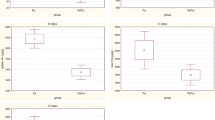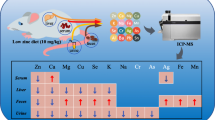Abstract
The effects of different levels of dietary boron were determined in vitamin D deficient rats. Vitamin D deficient diets containing either 0.158 ppm or 2.72 ppm of boron were fed to rats for 11 w, and calcium, magnesium, and phosphorus apparent absorption and balance were measured in the twelfth week. Higher apparent absorption and balance values for calcium and phosphorus were observed in the rats with higher dietary boron, but very few differences were seen in body wt, organ wt, and bone parameters. Balance measurements represented the present status of the rats after 12 w on the diets, but other measurements represented an accumulation over the lifetime of the rat, including a suckling period with ample vitamin D and boron. The data demonstrated that when rats are vitamin D deficient, as indicated by hypocalcemia, the level of boron in the diet affects mineral balance.
Similar content being viewed by others
References
C. D. Hunt and F. H. Nielsen, inTrace Element Metabolism in Man and Animals, 4th Intl. J. M. Howell, J. M. Gawthorne, and C. L. White, ed. Austral. Acad. Sci. Canberra, Australia, 597 (1981).
F. H. Nielson,Annual Review of Nutrition, vol. 4, W. J. Darby, ed. Annual Reviews Inc., Palo Alto, CA, 21 (1984).
C. D. Hunt,FASEB J. 3, A760 (1989).
B. Brossart and F. H. Nielson,ND Acad. Sci. 40, 128 (1986).
F. H. Nielsen, T. R. Shuler, T. J. Zimmerman, and E. O. Uthus,Biol. Trace Elem. Res. 17, 91 (1988).
F. H. Nielsen, D. R. Myron, S. H. Givand, and D. A. Ollerich,J. Nutr. 105, 1607 (1975).
P. S. Chen, Jr., T. Y. Toribara, and H. Warner,Anal. Chem. 28, 1756 (1956).
J. W. Pike,Nutr. Rev. 43, 161 (1985).
Personal communication with R. Brommage, Nestle Co., Switzerland.
J. L. Underwood, M. E. Phelps, and H. F. DeLuca,Proc. Natl. Acad. Sci. USA 81, 2352 (1984).
J. G. Penland,FASEB J. 4, A1045 (1990).
J. G. Penland,FASEB J. 3, A1242 (1989).
C. D. Hunt and F. H. Nielsen, In:6th Intl Symposium on Trace Elements in Man and Animals, L. S. Hurley, C. L. Keen, B. Lonnerdal, and R. B. Rucker, ed. Plenum Publishing, NY, NY, 275 (1988).
B. P. Halloran,Nutr. Rep. Intl. 31, 1149 (1985).
M. Keenan, M. Hegsted, and R. Mohan,FASEB J. 2, A1098 (1988).
J. L. Underwood and H. F. DeLuca,Am. J. Physiol. 246, E493 (1984).
F. H. Nielsen,FASEB J. 3, A760 (1989).
F. H. Nielsen, C. D. Hunt, L. M. Mullen, and J. R. Hunt,FASEB J. 1, 394 (1987).
Author information
Authors and Affiliations
Rights and permissions
About this article
Cite this article
Hegsted, M., Keenan, M.J., Siver, F. et al. Effect of boron on vitamin D deficient rats. Biol Trace Elem Res 28, 243–255 (1991). https://doi.org/10.1007/BF02990471
Received:
Accepted:
Issue Date:
DOI: https://doi.org/10.1007/BF02990471




